By Mike Smith
28th of September 2011
Please be warned - very graphic picture
There is no doubt that nature is beautiful. For instance, what can compare with the beautiful sunsets over a pacific island or the continent of Africa?
Nature also has a sense of humour. One just has to look at the Australian duckbill platypus or at the ugly mug of Julias Malema to appreciate the funny side of nature.
BTW. Some of my supporters have asked me why I keep on misspelling his name and calling him “Julias” instead of “Julius”
Well, on his atrocious Matric certificate his name is given as Julias Selo Malema
Nevertheless, Nature can also be extremely horrific and ugly. One only needs to think of the streptococcus bacteria, a spider sucking the juices from the body of its prey, a great white shark devouring a seal or a lion tearing a rabbit apart.
When one is a child, one has sympathy with the rabbit, but as one grows older and wiser one learns how nature works and one ends up shrugging the shoulders and say, “Hey, that is nature...the lion also has to eat.”
Until that lion is tearing your child apart instead of the rabbit. Then an entire hunting party will be put together and the lion along with probably a hundred other lions will be killed.
But why stop there? Would the logical conclusion not be to kill ALL lions and thus prevent any future attacks by lions on our children? What stops us from doing that?
It is, because deep down we know that Nature is in balance. If we kill all the lions, the rabbits will breed out of proportion and chow all the carrots, which means humans will all go blind and die out, because they won’t be able to find food anymore and they would mate with ugly, sick people and Darwin will spin around in his grave...
...No seriously. We instinctively know, or should know that interfering with nature is simply wrong, and that if we do, the repercussions will be enormous.
There are however, still people who see an elephant cow abandon her calf or a baboon female discarding its baby and these people still wants to interfere with nature. They then raise the animal by hand, only to find out that it will never be accepted into its herd, will forever be an outcast and will die living off the benevolence of its idiotic benefactors. Worse is when such an animal eventually turns on the benefactors and bites the hands that fed it, they want to appear astounded.
Eventually they discover that the mother of the animal knew instinctively to abandon it, because there was something wrong with it. They also discover that they were wrong to interfere with nature, but being the goody two shoes that they are they would never admit that they were wrong to interfere with nature, they would never admit that something was instinctively and genetically wrong with such an animal...no, they will look for the causes of the mother’s behaviour in social mistakes caused by bias or prejudice or whatever.
Below is a horrific article that appeared in the Afrikaans newspaper Beeld and later on IOL about a Black mother who threw her newborn baby, still linked to the placenta by the umbilical cord, onto a rubbish dump near a black township in Bloemfontein, South Africa.
This is quite common and news sites like News 24 or IOL reports almost daily on black babies found in toilets, rubbish bins or rubbish dumps...or dogs and pigs eating black babies.
In this specific case the baby was eaten by red ants but managed to survive. Workers on the rubbish dump found him and alerted ER24 the private ambulance company who took him to the Bloemfontein Medi Clinic where the White Afrikaans doctor, Dr. Jaco Neser saved his life and the white Afrikaans matron Ronel Vrey and her nursing staff, sucked the red Ants out of the nose of the black baby that they named Caleb Hope, because the ants almost suffocated him.
Well, once you give it a name you become emotionally attached to it...
Elzieta van Staden, the white Afrikaans spokesperson of Bloemfontein Medi Clinic said that the black baby is super sweet and being treated free of charge out of the benevolence of the white Afrikaans management of the Hospital.
Dr. Charné Gerber, the White Afrikaans woman who runs the Shiloh Zoe Hope Foundation , a non profit organisation that rescues unwanted black babies in Bloemfontein, reckons that Caleb will only be out of hospital in 90 days.
After all of this...these blacks will still sing “Kill the Boer, Kill the Farmer” and “One Settler;One Bullet”
The most worrying thing is that after all of this, the blacks will keep on raping torturing and killing whites, especially Afrikaners. They will keep on using AA and BEE and quotas at university and sports levels, against these White Afrikaners and at the same time have the audacity to call the Afrikaners, “Racists”.
Now how is it possible that these seemingly intelligent White Afrikaner medical staff at Bloemfontein Medi Clinic can be so stupid as to firstly, interfere with nature, but not only that, secondly, helping the offspring of their natural enemies for free... and thirdly, all at the cost of a white baby that they could have helped? What happened to charity begins at home?
Not a single one of the bleeding heart liberal medical staff ever set foot into poor white areas in the Freestate or Transvaal. To them, they could not give a damn about how many poor whites die of typhus, TB or malnutrition every year in the concentration camp that the new South Africa has become.
No, they go and scour the rubbish dumps of South Africa and fall over their feet to go and rescue abandoned black babies and treat them for free, while a million white Afrikaans mothers have to pay through their necks for such treatment.
Where is the logic in this? Why should one even bother with Afrikaners anymore? Why still frequent my blog? Shouldn’t we just sit back and observe the beauty of nature? Should we not just sit back and watch Afrikaners destroy themselves? Is it wrong for us to help Afrikaners? Is it wrong for us to interfere with nature?
After all, the hyenas also needs to eat...
Afrikaans article: Ants bite baby on rubbish dump
Baby eaten by ants found on rubbish dump
Pig eats black baby in South Africa
Dogs eats thrown away black baby in Gugulethu township near Cape Town
More dogs eating black babies at Samora Machel Township
Abandoned Black baby rescued out of toilet by White Afrikaner paramedic Leo Fourie, complete with picture
This black baby girl was three months old when found dead in a longdrop toilet
This one managed to survive
VERY GRAPHIC PICTURE
VERY GRAPHIC PICTURE
NOT FOR SENSITIVE VIEWERSA six months old baby inside a womb was today found inside a dustbin at a University of Limpopo in South Africa. It is believed that her mother made an illegal abotion. The incident happened early today when a cleaner realised a plastic that was full of blood, she wanted to find out what was inside the plastic and for her surprise, when she opened the plastic, it was a little baby who was six months. The student who may have done the incident was not yet known. When asking students at the recident where the incident happened they said, they do not know who may have done that, but they are very supprised why the person can do that.
Dr. Rammala who is the head of Sepedi language Research at University of Limpopo and well known in promoting morals says it is very surprising to see students doing illegitimate abotions while our government allows legal abotions. Other students believe what have happened is really wrong and immoral. “What happened is a sin, it is immoral and it is very disturbing” said one of the student who was witnesting the event.
The same incident also happened last year in 2007 at Tiro House where young first year students reside, and it is also said that even in 2006 it was witnessed at VL residence. Last year an 18 years student also was involved in an illegal abotion which happened in side a toilet.
Continue reading at NowPublic.com: Baby found in a dustbin in South African University | NowPublic Photo Archives http://www.nowpublic.com/strange/baby-found-dustbin-south-african-university-0#ixzz1ZFiIcfnq
Black baby found in dustbin at Limpopo University. Horrific photo. Not for the feint hearted
Wednesday, September 28, 2011
Monday, September 26, 2011
22 000More Delinquents
Basic Education Minister Angie Motshekga has backtracked on promises that the provincial department would fill 4000 vacant teaching posts. This week Motshekga, in an affidavit to the Bhisho High Court, said the department would, in fact, not be able to fill the posts as the provincial department had no money to pay the teachers.
This means we will have 22 000 more delinquents running around South Africa
http://www.peherald.com/news/article/2892
This means we will have 22 000 more delinquents running around South Africa
http://www.peherald.com/news/article/2892
Anatomy Of Terror
by Jan Lamprecht |
Here you will see a very rare publication. It was produced by the Rhodesian Government to show what the black Liberators did to their enemies and to those they suspected of working with the whites. Terrorism was also used as a way of getting the population to go along with them. 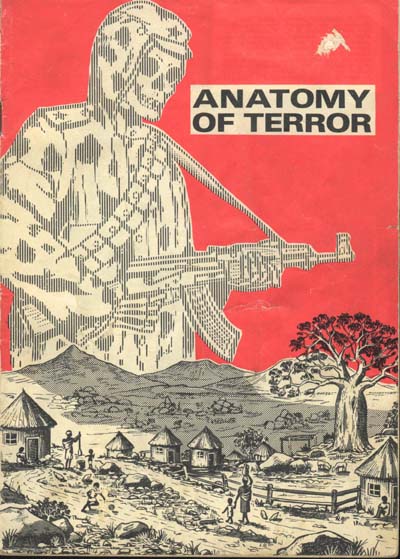 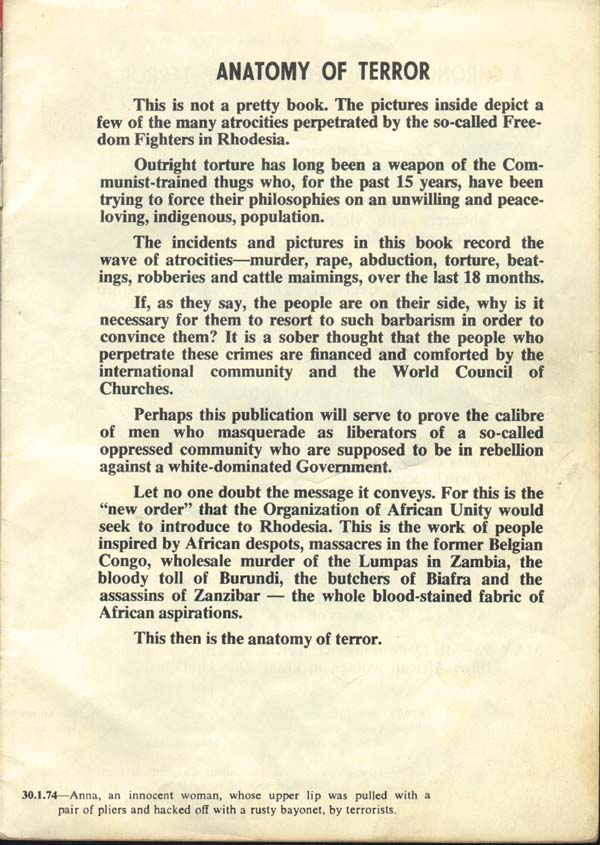 Let me explain how terror in the rural areas of Zimbabwe used to work. Note, it was very similar to what was done in Vietnam. Here is a short excerpt from Chapter 2 of my book, Government by Deception, which describes the general modus operandi:- The Liberators considered anyone who co-operated with the whites to be a "sell-out" or a traitor. They used sheer terror to prevent blacks from being friendly towards the whites. Any moderate black, who co-operated with the whites, was in danger of being beaten, or, worse still, murdered in the most brutal fashion imaginable. The Liberators were not nice, kind, democratic people. They were people who were hungry for power and who used any means to get it. They killed black and white civilians alike in a reign of terror in order to get their way. It is worth describing shortly, their basic approach. In Zimbabwe, the war was fought in the rural areas, often far away from civilisation. A gang of guerrillas would approach a village and gather together all the people who maybe numbered several hundred. They would try to convince the villagers to support them. They would even teach them politically orientated songs. They would indoctrinate them with Marxist ideology. But then they would warn them of what would happen to a sell-out. They would then pick a man from the audience, to demonstrate to the villagers what they would do to someone who co-operated with the whites. They might pick a man and then start beating him while forcing the villagers to watch. On some occasions they would begin cutting flesh from his living body. A favourite target was to cut a man's ears, or lips off. They might cut his lips off with a knife or a bayonet or even rip them off with pliers. Then they would call his wife and ask her to cook her husband's flesh. Then they would make her eat it. All this would be done in full view of the horrified villagers. They would beat the man, torture him some more and finally bayonet him to death. This, they would declare, is what will happen to anyone who co-operates with the whites. With out further ado, let us examine some photographs and let them do the talking: Mr. Chikombe Mazvida had his lips and ears cut off. His wife was forced to cook and eat the flesh:- 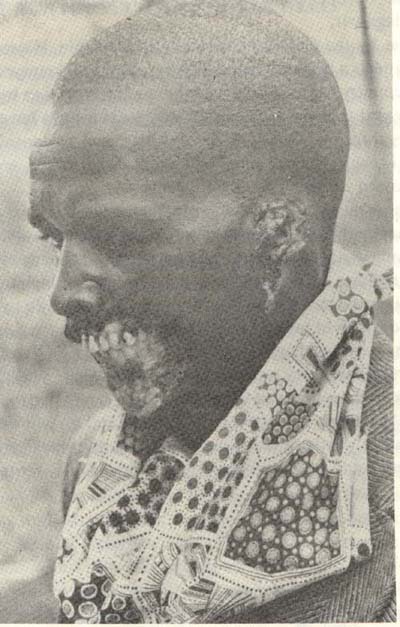 The Elim Mission Massacre In June 1978, terrorists killed 8 British missionaries at Elim Mission. They also killed 4 young children and a 3 week old baby. Note: These missionaries were at a mission station which was dedicated to helping and uplifting the black people. Note in the foreground the corpse of the little baby. These people came in the name of God to help the blacks and this was the thanks they got. It is very similar to the murder of Amy Bhiel, the American girl who came to South Africa's townships to help the blacks:-  Various idiots in the World Council of Churches and other places have been apologists for murders by the black Marxists, saying "they were motivated by love!" Can you believe it? Look at these young women, with pure hearts who had their lives snuffed out like this by Marxist garbage:-  30/01/1974: Anna, an innocent woman, whose upper lip was pulled with a pair of pliers, and hacked off with a rusty bayonet by terrorists. 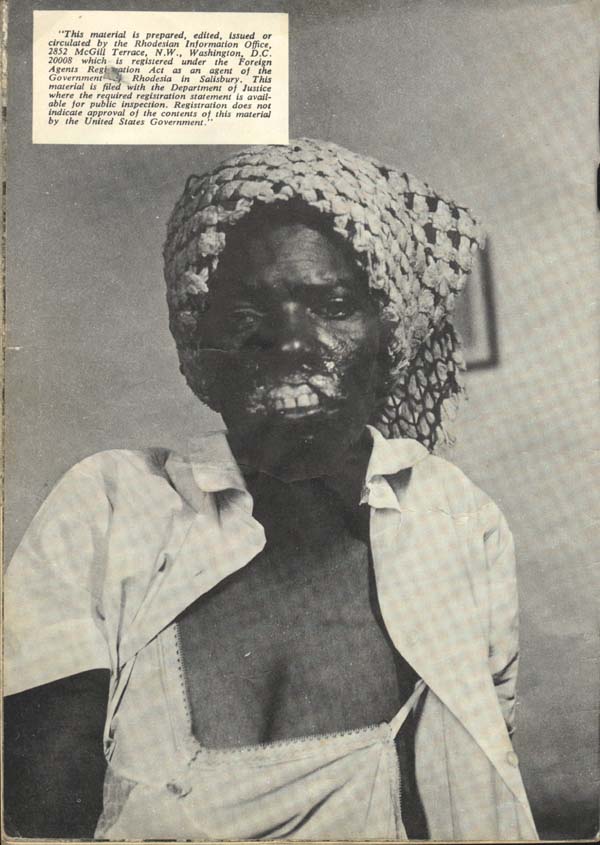 "Freedom Fighters" herded these men, women & children into this hut and then set fire to the thatched roof. I am not sure the exact location of this atrocity. It is most likely in Rhodesia (Zimbabwe). Such events happened a number of times, even in South Africa:-  Here is a page you can read which will give you an idea of many terrorist acts for which not photos are available. The list below could continue on and on for the next seven years. This is how Robert Mugabe came to power. These were their tactics. Read, and be disgusted. 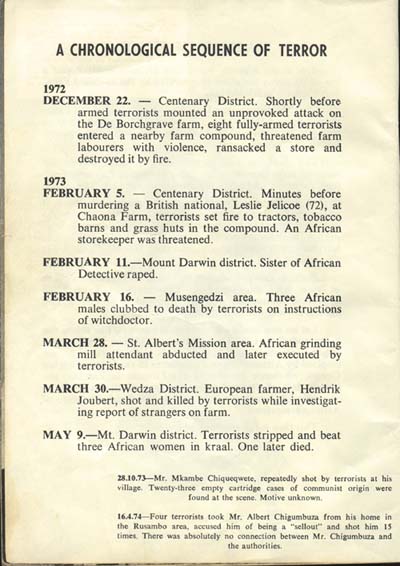 Top Photo: 28/10/1973: Mr. Mkambe Chiqueqwete, repeatedly shot by terrorists at his village. Twenty-three cartridge cases of communist origin were found at the scene. Motive unknown. 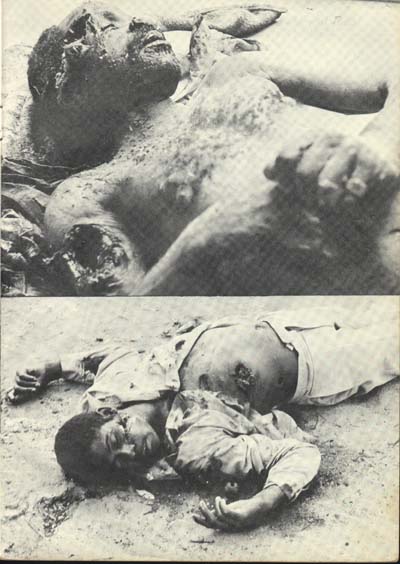 Bottom Photo: 16/04/1974: Four terrorists took Mr. Albert Chigumbuza from his home in the Rusambo area, accused him of being a "sellout" and shot him 15 times. There was absolutely no connection between Mr. Chigumbuza and the authorities. 17/04/1974: Mr. Chivarenge was the headman of a village. Ten terrorists approached him, accused him of being a "sellout", tied his hands behind his back and shot him. They then shot the 14 cattle which represented the entire village's worldly wealth and then set fire to the village. Mr. Chivarenge had led a blameless life and no motive is apparent.  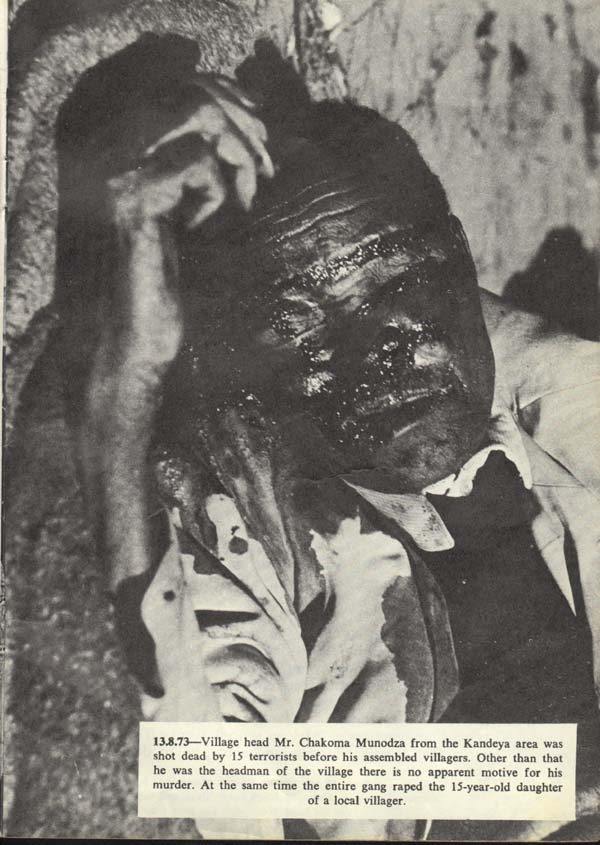 27/06/1973: The body of one of two Chief's Messengers was found in the Mt. Darwin district. They were abducted from their village and shot through the back of the head. No motive has been found. 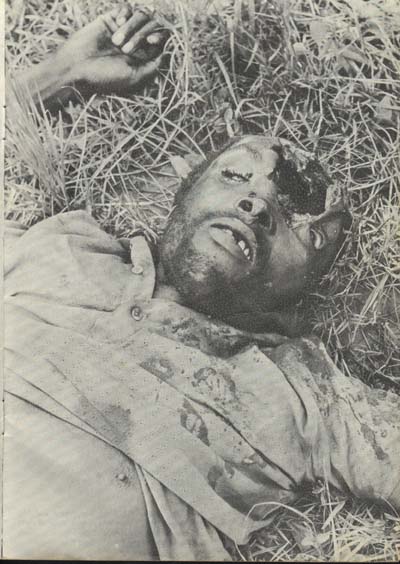 18/01/1974: Six terrorists took schoolteacher Mr. Enias Chakwanya and Mr Jairos Kachesa from their village in the Mt. Darwin district, laid them on the ground and beat them to death with a pole. The picture shows Mr. Chakwanya's body.  23/09/1974: The body of Mr. Goliat from the Kandeya area who was accused of helping the Security Forces. His hands were tied, he was made to kneel and shot six times. 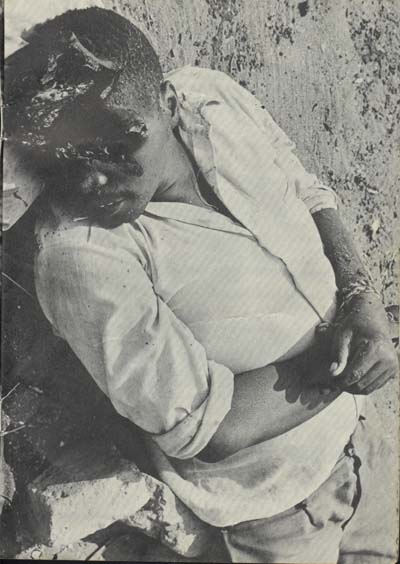 04/02/1974: The victim of a triple murder in the Kandeya area. He was beaten with sticks and shot for no apparent reason. 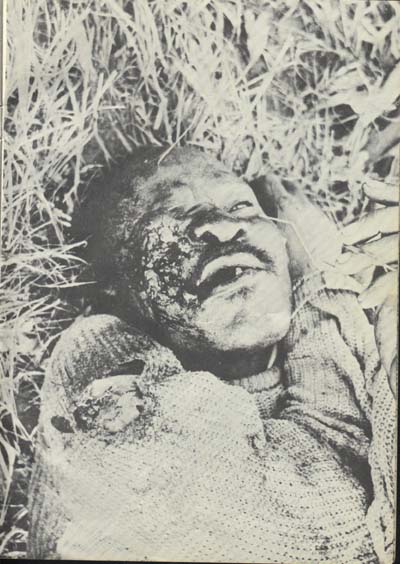 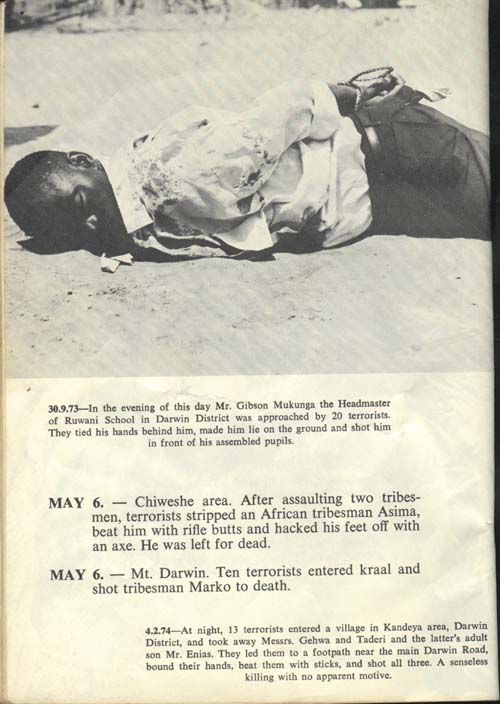 Take note above of the horrific atrocity of 6 May where a man had his feet chopped off. 04/02/1974: Thirteen terrorists entered a village in the Kandeya area, Darwin District. They took away Messrs. Gehawa and Taderi and the latter's adult son, Mr. Enias. They led them to a footpath near the main Darwin Road, bound their hands, beat them with sticks and shot all three. A senseless killing with no apparent motive. 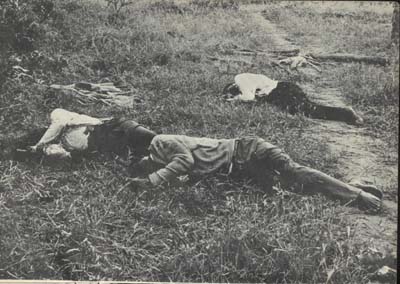 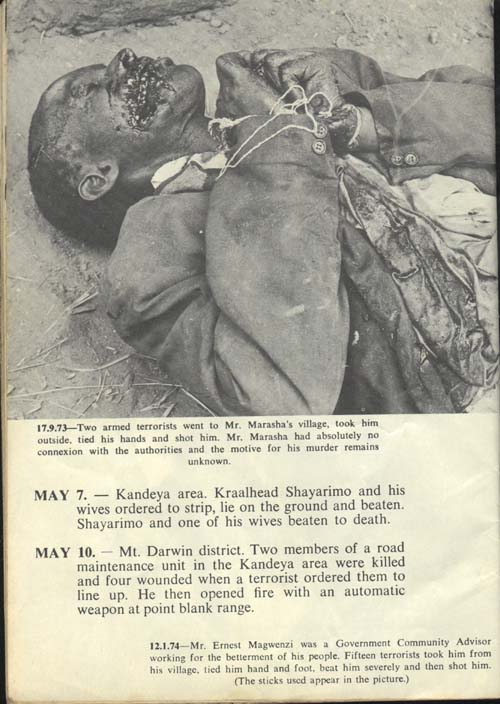 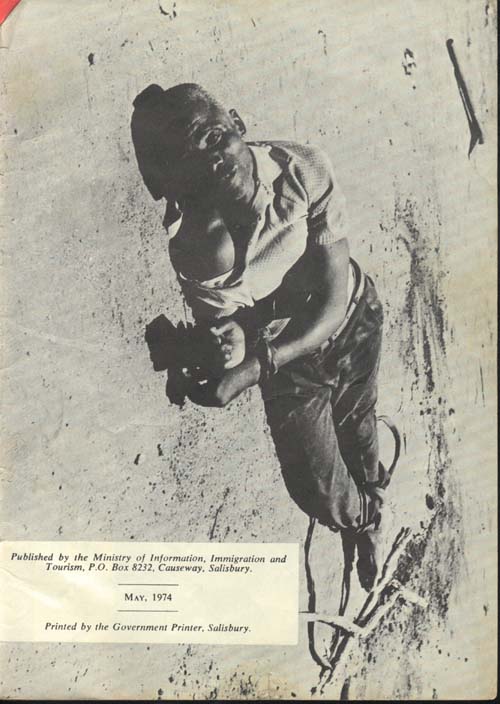 Shades of things to come. What is different between the senseless shooting of all these cattle in this village and the senseless burning and destroying of white farms in Zimbabwe today? The same old terrorist is at work causing untold senseless suffering just because he craves power. |
Budgeting for corruption
26 September, 2011
On Friday a colleague of mine went to take her driver's test. She failed, and it was not the first time - this was her fifth attempt.
Even before she got in the driver's seat her instructor told her she would have to pay a bribe to the testing official if she wanted to pass. He said this not because she was an incompetent driver or unprepared for the test. He told her this because it was just what she had to do - for her to pass the test, money needed to change hands.
Everyone makes jokes about the driver's test in South Africa. "Pay the bribe," we all joked with her beforehand.
The dilemma for her, a 23-year-old who has worked very hard to be where she is and is starting the arduous task of building her life, is that she is being told that, to get anywhere, she has to make peace with the fact that she has to pay a bribe. Someone who has honestly passed her university examinations is now being told that outside that world things work differently. She has to pay a bribe. She has to be corrupt.
How many young people are learning this devastating lesson about our country? How many young people are now facing the reality that hard work and honesty are not enough - that to get ahead one has to pay a bribe, bend the rules, be dishonest?
We all speak about corruption as though it is something that happens out there, to people we do not know. Corruption is now eating into the marrow of our being. It is becoming an everyday fact.
On Friday I gave a talk for 45 minutes on the political situation in South Africa. Afterwards, in conversation with one of the people who had attended, I realised that I had not even referred to corruption in my talk.
I realised that my omission was because of a simple yet devastating fact: I am beginning to think that corruption is normal - part of the South African way of life and therefore not even worth a proper mention and analysis.
Yet corruption is endemic. Most of my friends from elsewhere in Africa like to ask me if I want a "cold drink". It is their joke about South African policemen and women: every time my friends get stopped for some spurious reason, the policeman invariably asks for a "cold drink" to make whatever may be the problem go away.
The corruption problem is unlikely to go away. If anything, South African authorities are working hard to give the impression that crime pays and corruption will not be punished. The government continues to move with incredible slowness on some of the issues about which it should really be energetic.
Clear-cut cases of corruption are the Pretoria and Durban police-buildings lease deals. Various government officials, such as the suspended director-general of the Department of Public Works, have said they were essentially forced to sign the deals. Legal warnings not to sign the deals were ignored.
But the wheels of government have moved extremely slowly in dealing with this issue. Members of parliament - the "representatives of the people" - have even blocked opposition parties from asking the president questions about what he intends to do about these deals.
It is understandable that President Jacob Zuma has launched another inquiry into national police commissioner Bheki Cele's role in these deals because he has to act within the confines of the Police Act. But he is not so circumscribed with regard to Minister of Public Works Gwen Mahlangu-Nkabinde. He can fire her today. He can fire Minister of Co-operative Governance Sicelo Shiceka, who allegedly used taxpayers' money to visit a girlfriend in jail in Switzerland, today as well.
But Zuma has not done so. What message does that send? It says that we do not consider these transgressions and alleged acts of corruption to be serious and that, crucially, there will be no punishment.
In government work we see friends and relatives of powerful politicians become the beneficiaries of state tenders. The rest of the population has to pay a percentage of what they make on tenders to government officials or politicians.
This has now become the norm. We budget for corruption. It sits cheek by jowl with the rest of our life. It does not make us angry; we do not even mention it. It is just there and outrage is useless.
We watch our politicians battling for position and we point at those moving into new, big offices and say, admiringly: "It is his turn to eat."
We forget that it is the wealth and future of our friends, our children, of us as taxpayers, that is being eaten away by the corrupt.
http://www.timeslive.co.za/opinion/columnists/2011/09/26/budgeting-for-corruption
On Friday a colleague of mine went to take her driver's test. She failed, and it was not the first time - this was her fifth attempt.
Even before she got in the driver's seat her instructor told her she would have to pay a bribe to the testing official if she wanted to pass. He said this not because she was an incompetent driver or unprepared for the test. He told her this because it was just what she had to do - for her to pass the test, money needed to change hands.
Everyone makes jokes about the driver's test in South Africa. "Pay the bribe," we all joked with her beforehand.
The dilemma for her, a 23-year-old who has worked very hard to be where she is and is starting the arduous task of building her life, is that she is being told that, to get anywhere, she has to make peace with the fact that she has to pay a bribe. Someone who has honestly passed her university examinations is now being told that outside that world things work differently. She has to pay a bribe. She has to be corrupt.
How many young people are learning this devastating lesson about our country? How many young people are now facing the reality that hard work and honesty are not enough - that to get ahead one has to pay a bribe, bend the rules, be dishonest?
We all speak about corruption as though it is something that happens out there, to people we do not know. Corruption is now eating into the marrow of our being. It is becoming an everyday fact.
On Friday I gave a talk for 45 minutes on the political situation in South Africa. Afterwards, in conversation with one of the people who had attended, I realised that I had not even referred to corruption in my talk.
I realised that my omission was because of a simple yet devastating fact: I am beginning to think that corruption is normal - part of the South African way of life and therefore not even worth a proper mention and analysis.
Yet corruption is endemic. Most of my friends from elsewhere in Africa like to ask me if I want a "cold drink". It is their joke about South African policemen and women: every time my friends get stopped for some spurious reason, the policeman invariably asks for a "cold drink" to make whatever may be the problem go away.
The corruption problem is unlikely to go away. If anything, South African authorities are working hard to give the impression that crime pays and corruption will not be punished. The government continues to move with incredible slowness on some of the issues about which it should really be energetic.
Clear-cut cases of corruption are the Pretoria and Durban police-buildings lease deals. Various government officials, such as the suspended director-general of the Department of Public Works, have said they were essentially forced to sign the deals. Legal warnings not to sign the deals were ignored.
But the wheels of government have moved extremely slowly in dealing with this issue. Members of parliament - the "representatives of the people" - have even blocked opposition parties from asking the president questions about what he intends to do about these deals.
It is understandable that President Jacob Zuma has launched another inquiry into national police commissioner Bheki Cele's role in these deals because he has to act within the confines of the Police Act. But he is not so circumscribed with regard to Minister of Public Works Gwen Mahlangu-Nkabinde. He can fire her today. He can fire Minister of Co-operative Governance Sicelo Shiceka, who allegedly used taxpayers' money to visit a girlfriend in jail in Switzerland, today as well.
But Zuma has not done so. What message does that send? It says that we do not consider these transgressions and alleged acts of corruption to be serious and that, crucially, there will be no punishment.
In government work we see friends and relatives of powerful politicians become the beneficiaries of state tenders. The rest of the population has to pay a percentage of what they make on tenders to government officials or politicians.
This has now become the norm. We budget for corruption. It sits cheek by jowl with the rest of our life. It does not make us angry; we do not even mention it. It is just there and outrage is useless.
We watch our politicians battling for position and we point at those moving into new, big offices and say, admiringly: "It is his turn to eat."
We forget that it is the wealth and future of our friends, our children, of us as taxpayers, that is being eaten away by the corrupt.
http://www.timeslive.co.za/opinion/columnists/2011/09/26/budgeting-for-corruption
Affirmative Action
The fact is that the political majority requires affirmative action to protect them against a minority group is testament to a complete failure on their part to build their own wealth and doing some work, is such, that their only solution is to take it from others
Thursday, September 22, 2011
Canada grants white South African refugee status
A Canadian tribunal's decision to grant a white South African man refugee status has outraged the ruling party in South Africa.
Brandon Huntley, 31, said he could not return to South Africa because he was targeted for muggings and robberies because of his race.
Mr Huntley first went to Canada on a work permit in 2006, but he stayed on illegally and claimed refugee status.
He told the immigration board he was mugged and stabbed in seven attempted robberies in South Africa and that he was called a "white dog" and a "settler" during the attacks.
But he also said that he did not report the robberies to police because he did not trust them.
The Canadian refugee board agreed that there was persecution of whites by blacks in South Africa.
Ishmael Mnisi, a spokesman from South Africa's governing party, the African National Congress (ANC), says the decision itself is racist.
He says South Africa is a constitutional democracy which is fully able to fight crime.
"The African National Congress views the granting by Canada of a refugee status to South African citizen Brandon Huntley on the grounds that Africans would persecute him as racist," he said.
"We find the claim by Huntley to have been attacked seven times by Africans due to his skin colour - without any police intervention - sensational and alarming.
"Canada's reasoning for granting Huntley a refugee status can only serve to perpetuate racism."
But Mr Huntley's lawyer Russell Kaplan says the Canadian Refugee Board's decision is a reflection on South Africa's inability to protect its people from violent crime.
"The South African Government and the security forces could be willing, they really want to protect their citizens, but they can't and this is a really important point," he said.
"As long as a government is unable to protect its citizens, never mind the intent, there's the grounds legally for a refugee claim."
Canada's Globe and Mail newspaper quoted the refugee board member who made the ruling, William Davis, as saying there was convincing proof of the South African Government's inability or unwillingness to protect him.
One South African resident agrees with the ruling.
"I agree with him on that part because South Africa is mostly focusing on black people too much these days," the resident said.
"White people aren't given enough emphasis - basically, they've just paid for their sins for just too long."
But other locals agree with the Government that the ruling is racist.
"I think this guy is sick because if you check, we're living in South Africa, but none of these issues are happening to us, but even though if they are happening to you, how can you just run away from your country?" another resident said.
"I think he should come back and fix these matters."
'Crime is economic, not racial'
Geoffrey Hawker, the president of the African Studies Association and the head of politics at Macquarie University, says he was surprised at the ruling and is sceptical that the man was necessarily attacked on the basis of his skin colour.
"Most refugees tend to be those who are markedly in trouble, under privileged, on the run. I don't think we've had the case of a white South African coming into this situation before," he said.
"Most violence is actually black on black, that's the overwhelming reality. I'm not saying this case couldn't happen but it's not typical of what's happening in the country as a whole.
"Of course there are many rich whites, that's absolutely true, and of course they are the focus of robbery and other crimes - that's really not because they're white, that's because they're rich.
"And there are plenty of rich blacks now also in South Africa and they get targeted in full measure. The robber's after the money, not really after the person because of the colour of their skin.
"Crime reflects the socio-economic condition of the country, rather than its ethnic composition. Unemployment is so high and it tends to be concentrated in the black community and that's where much of the crime is coming from."
Dr Hawker says it is understandable that the ANC would be upset by the ruling.
"One can [understand why], because South Africa's going to get the reputation of the country where the blacks are deliberately setting out to punish the whites for the past injustices that were undoubtedly perpetrated," he said.
"If it were believed, if there were lots of cases like this, then they'd think that the whole reconciliation effort has fallen over and has become a sham and that would actually be a tragic failing for South Africa."
http://www.abc.net.au/news/2009-09-02/canada-grants-white-south-african-refugee-status/1414832
Monday, September 19, 2011
Prominent Afrikaans Newspaper refuses to publish VVK advertizing campaign
Pretoria,
South Africa,
18 September 2011
Prominent Afrikaans Newspaper refuses to publish VVK advertizing campaign.
By J. Mare
One week from today, the VVK elections will be a thing of the past and a new Afrikaner/Boer Council (Volksraad) will have been elected to administrate the affairs of this besieged community. Seven candidates will be sworn in to protect, lead and govern a small minority, constantly under threat of genocide by the government of South Africa - (The ANC).

A lot of hard work has gone into this campaign and many people have worked their fingers to the bone to make the will of the Afrikaner nation known by means of a democratic election.
This process wasn’t easy with many problems, that for some may have been, insurmountable.
Registration officials and other supporters are constantly attacked by ‘agents provocateurs’ and lured into debates with the aim to demonize the elections, the candidates, the administrators and even the council (even though it does not exist as yet).
Election officials report that people opposed to the process, are removing election posters in an attempt to influence the outcome.
On top of this, the Afrikaans media has proven to be the most venomous of all in their response to the elections.
It has come to our attention (from two independent sources) that one (very prominent and influential) Afrikaans newspaper, Die Beeld (NASPERS), has flatly refused to run the ad campaign for the elections, because of what they describe as the ads ‘political connotation’.
According to the chairman of the VVK, Paul Kruger, nothing could persuade them to even consider an amended version of the ad and, they even refused a suggestion to ‘just publish the logo and voting station addresses’.
The very same news group does not hesitate to run government announcements and other general South African election advertisements.
If you are interested in reading ANC government propaganda (in Afrikaans), please click here: Beeld
This is the ad they rejected:
Why is Naspers doing this?
Be it as it may, the commission will now have to rely on the electronic and social media networks to advertize its intent to hold these important elections and hope that Afrikaners will wake up and realize what these ANC controlled media moguls are doing, by feeding them a daily dose of government propaganda.
Why do they fear and dread this election and its outcome?

Could it be that the power of the ‘democratic voice’ of the People will be the death knell of its monopoly and control over the masses ?
Could it be that they fear retribution from their ANC masters or, are they naïvely believing that they are doing the nation a favor by withholding this information, because…. ‘nobody will be interested’?
NASPERS answer:
“Why should we vote?”Afrikaners are at the mercy of a murderous black regime, intent at eradicating them from the South African landscape. Racist ANC legislation, has caused abject poverty among 800 000 members of this vulnerable minority.
Other reasons:
The information they don’t want the Afrikaner community to know.
The elections will be held on the 24th of September 2011 from 07:00 AM in the morning until 21:00 PM when the voting stations will close and your chance to vote will expire.
Those Afrikaners who haven’t registered or who don’t know whether their names appear on the voters roll, will be allowed to register on the spot and vote, providing that they qualify as voters!
These are the Qualifications:
1) You must be an Afrikaner of age eighteen or older.
2) You must be in possession of a valid ‘SA identification document’ and/or ‘drivers license’ and be able to hand it to the registration official for verification on voting day.
3) You must be a person, that is readily identifiable as an individual that belongs to and forms part of the Afrikaner/Boer nation and/or associate with the culture, language, aspirations and destiny.
4) You can report to any of the following voting stations on voting day, where you will be allowed to vote for the candidate of your choice as council member.
Voting Stations:

(Please verify the accuracy of this information on the VVK website – on voting day)
REGION 1: FAR NORTHERN-TRANSVAAL
1.Messina: Paul Millsstraat 42.
2.Louis Trichardt: Kroghstraat 136.
3.Ellisras: Boereverenigingsaal, ongeveer 2 km. op Ellisras/Marken-pad.
4.Phalaborwa: Bateleurstraat 31.
5.Pietersburg: Laerskool Pietersburg, h/v Voortrekker- & “Thabo Mbeki”straat.
6.Potgietersrus: Hoogestraat 126.
7.Tzaneen: Sanloo Gastehuis, Feesstr.
8. Baltimore: Boeresaal in hoofstraat op N11.
REGION 2: NORTHERN-TRANSVAAL
1.Hoedspruit: Sunset View-winkelkompleks Eenh. E, langs Fort Koepiba-hotel en slaghuis.
2.Groblersdal: Hervormde Kerksaal, Voortrekkerstraat.
3.Naboomspruit: Limpopo Pale, Eerstestr. 52
4.Thabazimbi: Trollipsaal, Skougronde.
5.Vaalwater: Landbou-Unie Vendusiekrale, ongeveer 4 km. op Melkrivier/Vierentwintigriviere-pad. 13
6.Nylstroom: Stoeisaal in Kerkstraat-Oos langs sportgronde.
7.Warmbad: AP Kerk, h/v Huilbos- en Katjiepieringlaan.
8.Cullinan: Landbou-Uniesaal, ongeveer 2 km. op Cullinan/Bronkhorstspruitpad.
9.Hartebeespoort: Jasmyn Winkelsentrum.
10.Pretoria – Wes: AP Kerkterrein, Hannystraat.
11.Pretoria – Moot: W. Marais Afrikanersentrum, Paul Krugerstraat.
12.Pretoria – Noord(1): AP Kerkterrein Wonderboom, h/v Daan De Wet Nel- & 7de Straat.
13.Pretoria – Noord(2): AP Kerkterrein Transmagalies, Springbokvlakteweg, Montana.
14.Pretoria – Oos: Skool op die h/v Witdoring- en De Villebois Mareuilstraat, Moreleta Park.
15.Verwoerdburg: Gereformeerde Kerkterrein, h/v Aletheastraat en Basdenlaan, Lyttelton.
16.Kleinfontein: Kleinfontein Gemeenskapsentrum.
17.Welbekend/Bapsfontein: Hoewe 164, Bashewa op Welbekendpad.
18.Bronkhorstspruit: Hoewe in Louis Bothastraat-verlenging, net oos van die Delmas/Groblersdal-pad.
REGION 3: EASTERN-TRANSVAAL
1.Barberton: Jathira-Winkel op Nelspruit-pad.
2.Nelspruit: Geloftefeesterrein, Ehmkestraat oorkant NG Kerk.
3.Witrivier: Witrivier Rolbalklub, Makadiamastraat.
4.Malelane: Plaas Riverside, Huis 1, ged. 1, op Malelane Hek-pad na Kruger Wildtuin.
5.Sabie: Sabie Aftree-oord Nr. 5, Wallisstraat.
6.Lydenburg: Steynstraat 19.
7.Machadodorp: Voortrekkerstraat 4.
8.Middelburg: Hoër Tegniese Skool Middelburg, h/v Fontein- (“Samora Machel”) en Zuidstraat.
9.Roossenekal: SAVF-terrein, h/v Zulch- & Middelstraat.
10.Belfast: Fitzgeraldstraat 65.
11.Hendrina: Kortstraat 11.
12.Carolina: Hugostraat 77.
13.Ermelo: Radio Ermelo-gebou, h/v Border- & Smutsstraat.
14.Lothair: Boeresaal, Mainstraat.
15.Piet Retief: Klopperstraat 15A.
16.Utrecht: Van Rooyenstraat 6
17.Vryheid: Gelofte CVO Akademie, h/v Park- & Smalstraat.
18.Krugerspos: Vlakfonteinpad, Nr.AD8
REGION4: HIGHVELD
1.Bethal: AP Kerksaal Moedergemeente, Blesbokspruit.
2.Secunda: Davieshof Sentrum, h/v Helen Joseph- & Jan Smutsstraat.
3.Kriel: Kraanvoëlstraat 9.
4.Witbank: Prestige Sentrum, Watermeyerstraat.
5.Delmas: Malita Aftree-oord, Sesdestraat.
6.Nigel: Beverly-weg 50.
7.Heidelberg: h/v Aspey- en Viljoenstraat.
8.Standerton: Charl Cilliersstraat 92.
9.Volksrust: Platorand Staalwerke, Joubertstraat 78.
REGION 5: GREATER JHB
1.Springs: Ermeloweg, in Pet Hyper langs Holiday Inn-padkafee.
2.Brakpan: AP Kerkterrein, h/v Middel- en Collieryweg, Rand Colleries.
3.Benoni: AP Kerkterrein, h/v Stokroos- en Oakstraat, Northmead x4.
4.Kempton Park: AP Kerkterrein, h/v Rietfontein- en Pionierstraat, Glen Marais Park.
5.Sandton / Midrand: (Stem in Verwoerdburg).
6.Randburg: Vyfdestraat 15, Linden.
7.Krugersdorp: Harlekyne rugbyklub, Wagenstraat, Burgershoop.
8.Roodepoort: AP Kerkterrein, Corlette-rylaan 855, Witpoortjie/Princess.
9.Randfontein: Driehoek Vleismark, langs HF Verwoerd-stadion.
10.Johannesburg: AP Kerkterrein, Chamberstraat 20, Booysens.
11.Germiston: AP Kerkterrein, Oosthuizenstraat.
12.Boksburg/Primrose: AP Kerkterrein, h/v Medlarweg en Bardiastraat, Wannenburghoogte.
13.Alberton: AP Kerkterrein, Bloekomlaan, Genl. Albertspark.
14.Meyerton: AP Kerkterrein, h/v Leyds- en Juniusstraat.
15.Vereeniging: Genl. Hertzogstraat 124, oorkant winkelsentrum langs Dros.
16.Vanderbijlpark: J & B Driving Range-lapa, Cornwallis Harrisstraat 758.
REGION 6: WEST-TRANSVAAL
1.Zeerust: AP Kerkterrein, Bankstraat.
2.Swartruggens: Skousaal.
3.Rustenburg: Kloofsentrum 175, Kockstraat.
4.Brits: Hoërskool Brits saal, h/v de Ridder- en Schuttelaan.
5.Koster: Koster Bande, Millstraat 5.
6.Lichtenburg: 13de laan 2, Burgersdorp.
7.Coligny: AP Kerkterrein, h/v Park- en Vincentstraat.
8.Ventersdorp: Rothstraat 25.
9.Carletonville: Evangelies-Gereformeerde Kerkterrein, Grundlingstraat 49.
10.Potchefstroom: H/v Goudstraat en “Albert Luthuli”weg.
11.Klerksdorp. Moolmanstraat 2 (Gastehuis).
12.Delareyville: Governmentstraat 27.
13.Schweizer-Reneke: Landbousaal Lapa.
14.Wolmaransstad: Leaskstraat 76.
15.Makwassie: Ellisstraat 20.
16.Christiana: Voortrekkerstr. 8A
17.Ottosdal: Moorecroft straat 45.
18.Migdol: Boeresaal.
19.Hartswater: Border Hotelsaal, Jan Kempdorpstraat.
20.Hartbeespoort: Jasmyn Winkelkompleks, Schoemansville.
REGION 7: NORTHERN FREE STATE
1.Parys / Vredefort: Forumgebou, h/v Liebenberg-, Philip- & Kerkstrate.
2.Heilbron: Ou Kommandokantore, h/v Luyt- en Pienaarstraat.
3.Kroonstad: AP Kerkterrein, Buitensorg Hoewe 8.
4.Welkom: Boland gebou, Elizabethstraat.
5.Virginia: Civiclaan 29.
REGION 8: EASTERN FREE STATE
1.Vrede: Duiwesaal, Skougronde.
2.Memel: Memel Boereverenigingsaal.
3.Reitz: Roosstraat 58, Savvas-gebou.
4.Bethlehem: AP Kerkterrein, h/v Paul Gent- en Alex Paxinnostraat, Panorama.
5.Clocolan: Skougronde, Geloftefeessaal.
REGION 9: TRANSORANJE
1.Brandfort: Voortrekkerstraat, oorkant Stadsaal.
2.Bloemfontein: Dr. Böhmer-skool, Haldonweg.
3.Dutoitspan (Kimberley): Gereformeerde Kerkterrein, Kekewichrylaan, Monumenthoogte.
4.Phillipolis: Tobie Mullerstraat 6.
REGION 10: NORTHERN-CAPE
1.Vryburg: Winkel 2, Moloposentrum, Molopoweg.
2.Kuruman: Moffat sendingstasie.
3.Kathu: Kokerboomstraat 53.
4.Upington: Werda Gastehuis, Schröderstraat 148.
5.Orania: AP Kerkterrein, Perellaan 150.
REGION 11: WEST COAST
1.Port Nolloth: Noordweg 1854.
2.Vanrhynsdorp: AP Kerkterrein Olifantsrivier, Skoolstraat.
3.Clanwilliam: AP Kerkterrein, Voortrekkerstraat.
REGION 12: WESTERN CAPE
1.Piketberg: Kunsgallery by Pools, 10km. op N7 Noord.
2.Kaapstad/Parow: AP Kerkterrein, Van Riebeeckstr 22, Parow.
3.Stellenbosch: (om bevestig te word).
4.Strand: Burenstraat 14.
5.Hermanus: Demond Karavaanpark, 10de straat, Voëlklip.
6.Bredasdorp: Breëstraat 12.
7.Struisbaai: Romansingel 11.
8.Stilbaai: Excelsiorstraat 12, Stilbaai-Wes.
9.Oudtshoorn: Greeffstraat 122.
10.George: Voortrekkersaal, Caledonstraat.
11.Plettenbergbaai: Mangoldpunt 5.
12.Ashton: Fanie’s Kitchen, Hoofweg 22.
13.Velddrif: Smitlaan 5, oorkant NG-kerk.
REGION 13: KAROO
1.Carnarvon: (Om bevestig te word).
2.Fraserburg: CVO Fraserburg.
3.Sutherland: NG Kerksaal.
4.Beaufort-Wes: Royal Lodge, Donkinstraat.
REGION 14: EASTERN CAPE
1.Molteno: Plaas Grassdale, 16 km. uit Molteno op Dordrecht-pad.
2.Port Elizabeth: Murraypark, Draaifonteinweg, Groenbossies Hoewe 1 EEM.
3.Uitenhage: Mitchellstraat 5.
4.Dordrecht: Plaas Avondzon, S31*14.824EO27*17.617 35 km. uit Dordrecht op Barkly-Oos pad.
5.Lady Grey: Plaas van Zylsrust, ongeveer 5 km. uit dorp op Aliwal Noord/Barkly-Oos pad.
6.Jeffreysbaai: Magnoliastraat 31, Wavecrest.
REGION 15: NATAL
1.Newcastle: Drakensberg Primêre Skool, Paddocklaan, Pionierpark.
2.Dundee: Volwasse sentrum, Victoriaweg.
3.Ladysmith / Estcourt / Pietermaritzburg: (Om bevestig te word).
4.Richardsbaai / Empangeni: (Om bevestig te word).
5.Durban: (Om bevestig te word).
6.Ramsgate: Marine drive 57, oorkant “Skulpiewinkel”.
http://afrikanerjournal.wordpress.com/2011/09/19/prominent-afrikaans-newspaper-refuses-to-publish-vvk-election-ads/
South Africa,
18 September 2011
Prominent Afrikaans Newspaper refuses to publish VVK advertizing campaign.
By J. Mare
One week from today, the VVK elections will be a thing of the past and a new Afrikaner/Boer Council (Volksraad) will have been elected to administrate the affairs of this besieged community. Seven candidates will be sworn in to protect, lead and govern a small minority, constantly under threat of genocide by the government of South Africa - (The ANC).

Some 800 000 Afrikaners live in structures like this. The ANC intends to destroy these shacks, without providing adequate alternative housing - Photo, The Afrikaner Journal - 09082011
A lot of hard work has gone into this campaign and many people have worked their fingers to the bone to make the will of the Afrikaner nation known by means of a democratic election.
This process wasn’t easy with many problems, that for some may have been, insurmountable.
Registration officials and other supporters are constantly attacked by ‘agents provocateurs’ and lured into debates with the aim to demonize the elections, the candidates, the administrators and even the council (even though it does not exist as yet).
Election officials report that people opposed to the process, are removing election posters in an attempt to influence the outcome.
On top of this, the Afrikaans media has proven to be the most venomous of all in their response to the elections.
It has come to our attention (from two independent sources) that one (very prominent and influential) Afrikaans newspaper, Die Beeld (NASPERS), has flatly refused to run the ad campaign for the elections, because of what they describe as the ads ‘political connotation’.
According to the chairman of the VVK, Paul Kruger, nothing could persuade them to even consider an amended version of the ad and, they even refused a suggestion to ‘just publish the logo and voting station addresses’.
The very same news group does not hesitate to run government announcements and other general South African election advertisements.
If you are interested in reading ANC government propaganda (in Afrikaans), please click here: Beeld
This is the ad they rejected:
Why is Naspers doing this?
Be it as it may, the commission will now have to rely on the electronic and social media networks to advertize its intent to hold these important elections and hope that Afrikaners will wake up and realize what these ANC controlled media moguls are doing, by feeding them a daily dose of government propaganda.
Why do they fear and dread this election and its outcome?

'Uncle Jacques, why is the ANC destroying our home? '- Photo, The Afrikaner Journal - 09082011 - ANC metro council destroys another Afrikaner home!
Could it be that the power of the ‘democratic voice’ of the People will be the death knell of its monopoly and control over the masses ?
Could it be that they fear retribution from their ANC masters or, are they naïvely believing that they are doing the nation a favor by withholding this information, because…. ‘nobody will be interested’?
NASPERS answer:
“Why should we vote?”
Other reasons:
- ‘Genocide Watch’ upgrades Afrikaner Genocide to Stage 6
- Destitute elderly – forcefully removed and tear-gassed by local council.
- VVK registration campaign – Daspoort, Pretoria – (forced evictions discussed)
- Championing Europe’s Leadership in the Fight Against Extreme Poverty: – The South African perspective – The Afrikaner Journal
- Land invasion – ANC begins its ethnic cleansing campaign
What the ANC and its allies are calling for, is the complete destruction of the Afrikaner/Boer nation by all means at their disposal and by using every apparatus of state to starve and strangle them to death.
This is the reason they need self-governance.
This is the reason all Afrikaners/ Boers should cast their votes on 24 September 2011
The information they don’t want the Afrikaner community to know.
The elections will be held on the 24th of September 2011 from 07:00 AM in the morning until 21:00 PM when the voting stations will close and your chance to vote will expire.
Those Afrikaners who haven’t registered or who don’t know whether their names appear on the voters roll, will be allowed to register on the spot and vote, providing that they qualify as voters!
These are the Qualifications:
1) You must be an Afrikaner of age eighteen or older.
2) You must be in possession of a valid ‘SA identification document’ and/or ‘drivers license’ and be able to hand it to the registration official for verification on voting day.
3) You must be a person, that is readily identifiable as an individual that belongs to and forms part of the Afrikaner/Boer nation and/or associate with the culture, language, aspirations and destiny.
4) You can report to any of the following voting stations on voting day, where you will be allowed to vote for the candidate of your choice as council member.
Voting Stations:

(Please verify the accuracy of this information on the VVK website – on voting day)
REGION 1: FAR NORTHERN-TRANSVAAL
1.Messina: Paul Millsstraat 42.
2.Louis Trichardt: Kroghstraat 136.
3.Ellisras: Boereverenigingsaal, ongeveer 2 km. op Ellisras/Marken-pad.
4.Phalaborwa: Bateleurstraat 31.
5.Pietersburg: Laerskool Pietersburg, h/v Voortrekker- & “Thabo Mbeki”straat.
6.Potgietersrus: Hoogestraat 126.
7.Tzaneen: Sanloo Gastehuis, Feesstr.
8. Baltimore: Boeresaal in hoofstraat op N11.
REGION 2: NORTHERN-TRANSVAAL
1.Hoedspruit: Sunset View-winkelkompleks Eenh. E, langs Fort Koepiba-hotel en slaghuis.
2.Groblersdal: Hervormde Kerksaal, Voortrekkerstraat.
3.Naboomspruit: Limpopo Pale, Eerstestr. 52
4.Thabazimbi: Trollipsaal, Skougronde.
5.Vaalwater: Landbou-Unie Vendusiekrale, ongeveer 4 km. op Melkrivier/Vierentwintigriviere-pad. 13
6.Nylstroom: Stoeisaal in Kerkstraat-Oos langs sportgronde.
7.Warmbad: AP Kerk, h/v Huilbos- en Katjiepieringlaan.
8.Cullinan: Landbou-Uniesaal, ongeveer 2 km. op Cullinan/Bronkhorstspruitpad.
9.Hartebeespoort: Jasmyn Winkelsentrum.
10.Pretoria – Wes: AP Kerkterrein, Hannystraat.
11.Pretoria – Moot: W. Marais Afrikanersentrum, Paul Krugerstraat.
12.Pretoria – Noord(1): AP Kerkterrein Wonderboom, h/v Daan De Wet Nel- & 7de Straat.
13.Pretoria – Noord(2): AP Kerkterrein Transmagalies, Springbokvlakteweg, Montana.
14.Pretoria – Oos: Skool op die h/v Witdoring- en De Villebois Mareuilstraat, Moreleta Park.
15.Verwoerdburg: Gereformeerde Kerkterrein, h/v Aletheastraat en Basdenlaan, Lyttelton.
16.Kleinfontein: Kleinfontein Gemeenskapsentrum.
17.Welbekend/Bapsfontein: Hoewe 164, Bashewa op Welbekendpad.
18.Bronkhorstspruit: Hoewe in Louis Bothastraat-verlenging, net oos van die Delmas/Groblersdal-pad.
REGION 3: EASTERN-TRANSVAAL
1.Barberton: Jathira-Winkel op Nelspruit-pad.
2.Nelspruit: Geloftefeesterrein, Ehmkestraat oorkant NG Kerk.
3.Witrivier: Witrivier Rolbalklub, Makadiamastraat.
4.Malelane: Plaas Riverside, Huis 1, ged. 1, op Malelane Hek-pad na Kruger Wildtuin.
5.Sabie: Sabie Aftree-oord Nr. 5, Wallisstraat.
6.Lydenburg: Steynstraat 19.
7.Machadodorp: Voortrekkerstraat 4.
8.Middelburg: Hoër Tegniese Skool Middelburg, h/v Fontein- (“Samora Machel”) en Zuidstraat.
9.Roossenekal: SAVF-terrein, h/v Zulch- & Middelstraat.
10.Belfast: Fitzgeraldstraat 65.
11.Hendrina: Kortstraat 11.
12.Carolina: Hugostraat 77.
13.Ermelo: Radio Ermelo-gebou, h/v Border- & Smutsstraat.
14.Lothair: Boeresaal, Mainstraat.
15.Piet Retief: Klopperstraat 15A.
16.Utrecht: Van Rooyenstraat 6
17.Vryheid: Gelofte CVO Akademie, h/v Park- & Smalstraat.
18.Krugerspos: Vlakfonteinpad, Nr.AD8
REGION4: HIGHVELD
1.Bethal: AP Kerksaal Moedergemeente, Blesbokspruit.
2.Secunda: Davieshof Sentrum, h/v Helen Joseph- & Jan Smutsstraat.
3.Kriel: Kraanvoëlstraat 9.
4.Witbank: Prestige Sentrum, Watermeyerstraat.
5.Delmas: Malita Aftree-oord, Sesdestraat.
6.Nigel: Beverly-weg 50.
7.Heidelberg: h/v Aspey- en Viljoenstraat.
8.Standerton: Charl Cilliersstraat 92.
9.Volksrust: Platorand Staalwerke, Joubertstraat 78.
REGION 5: GREATER JHB
1.Springs: Ermeloweg, in Pet Hyper langs Holiday Inn-padkafee.
2.Brakpan: AP Kerkterrein, h/v Middel- en Collieryweg, Rand Colleries.
3.Benoni: AP Kerkterrein, h/v Stokroos- en Oakstraat, Northmead x4.
4.Kempton Park: AP Kerkterrein, h/v Rietfontein- en Pionierstraat, Glen Marais Park.
5.Sandton / Midrand: (Stem in Verwoerdburg).
6.Randburg: Vyfdestraat 15, Linden.
7.Krugersdorp: Harlekyne rugbyklub, Wagenstraat, Burgershoop.
8.Roodepoort: AP Kerkterrein, Corlette-rylaan 855, Witpoortjie/Princess.
9.Randfontein: Driehoek Vleismark, langs HF Verwoerd-stadion.
10.Johannesburg: AP Kerkterrein, Chamberstraat 20, Booysens.
11.Germiston: AP Kerkterrein, Oosthuizenstraat.
12.Boksburg/Primrose: AP Kerkterrein, h/v Medlarweg en Bardiastraat, Wannenburghoogte.
13.Alberton: AP Kerkterrein, Bloekomlaan, Genl. Albertspark.
14.Meyerton: AP Kerkterrein, h/v Leyds- en Juniusstraat.
15.Vereeniging: Genl. Hertzogstraat 124, oorkant winkelsentrum langs Dros.
16.Vanderbijlpark: J & B Driving Range-lapa, Cornwallis Harrisstraat 758.
REGION 6: WEST-TRANSVAAL
1.Zeerust: AP Kerkterrein, Bankstraat.
2.Swartruggens: Skousaal.
3.Rustenburg: Kloofsentrum 175, Kockstraat.
4.Brits: Hoërskool Brits saal, h/v de Ridder- en Schuttelaan.
5.Koster: Koster Bande, Millstraat 5.
6.Lichtenburg: 13de laan 2, Burgersdorp.
7.Coligny: AP Kerkterrein, h/v Park- en Vincentstraat.
8.Ventersdorp: Rothstraat 25.
9.Carletonville: Evangelies-Gereformeerde Kerkterrein, Grundlingstraat 49.
10.Potchefstroom: H/v Goudstraat en “Albert Luthuli”weg.
11.Klerksdorp. Moolmanstraat 2 (Gastehuis).
12.Delareyville: Governmentstraat 27.
13.Schweizer-Reneke: Landbousaal Lapa.
14.Wolmaransstad: Leaskstraat 76.
15.Makwassie: Ellisstraat 20.
16.Christiana: Voortrekkerstr. 8A
17.Ottosdal: Moorecroft straat 45.
18.Migdol: Boeresaal.
19.Hartswater: Border Hotelsaal, Jan Kempdorpstraat.
20.Hartbeespoort: Jasmyn Winkelkompleks, Schoemansville.
REGION 7: NORTHERN FREE STATE
1.Parys / Vredefort: Forumgebou, h/v Liebenberg-, Philip- & Kerkstrate.
2.Heilbron: Ou Kommandokantore, h/v Luyt- en Pienaarstraat.
3.Kroonstad: AP Kerkterrein, Buitensorg Hoewe 8.
4.Welkom: Boland gebou, Elizabethstraat.
5.Virginia: Civiclaan 29.
REGION 8: EASTERN FREE STATE
1.Vrede: Duiwesaal, Skougronde.
2.Memel: Memel Boereverenigingsaal.
3.Reitz: Roosstraat 58, Savvas-gebou.
4.Bethlehem: AP Kerkterrein, h/v Paul Gent- en Alex Paxinnostraat, Panorama.
5.Clocolan: Skougronde, Geloftefeessaal.
REGION 9: TRANSORANJE
1.Brandfort: Voortrekkerstraat, oorkant Stadsaal.
2.Bloemfontein: Dr. Böhmer-skool, Haldonweg.
3.Dutoitspan (Kimberley): Gereformeerde Kerkterrein, Kekewichrylaan, Monumenthoogte.
4.Phillipolis: Tobie Mullerstraat 6.
REGION 10: NORTHERN-CAPE
1.Vryburg: Winkel 2, Moloposentrum, Molopoweg.
2.Kuruman: Moffat sendingstasie.
3.Kathu: Kokerboomstraat 53.
4.Upington: Werda Gastehuis, Schröderstraat 148.
5.Orania: AP Kerkterrein, Perellaan 150.
REGION 11: WEST COAST
1.Port Nolloth: Noordweg 1854.
2.Vanrhynsdorp: AP Kerkterrein Olifantsrivier, Skoolstraat.
3.Clanwilliam: AP Kerkterrein, Voortrekkerstraat.
REGION 12: WESTERN CAPE
1.Piketberg: Kunsgallery by Pools, 10km. op N7 Noord.
2.Kaapstad/Parow: AP Kerkterrein, Van Riebeeckstr 22, Parow.
3.Stellenbosch: (om bevestig te word).
4.Strand: Burenstraat 14.
5.Hermanus: Demond Karavaanpark, 10de straat, Voëlklip.
6.Bredasdorp: Breëstraat 12.
7.Struisbaai: Romansingel 11.
8.Stilbaai: Excelsiorstraat 12, Stilbaai-Wes.
9.Oudtshoorn: Greeffstraat 122.
10.George: Voortrekkersaal, Caledonstraat.
11.Plettenbergbaai: Mangoldpunt 5.
12.Ashton: Fanie’s Kitchen, Hoofweg 22.
13.Velddrif: Smitlaan 5, oorkant NG-kerk.
REGION 13: KAROO
1.Carnarvon: (Om bevestig te word).
2.Fraserburg: CVO Fraserburg.
3.Sutherland: NG Kerksaal.
4.Beaufort-Wes: Royal Lodge, Donkinstraat.
REGION 14: EASTERN CAPE
1.Molteno: Plaas Grassdale, 16 km. uit Molteno op Dordrecht-pad.
2.Port Elizabeth: Murraypark, Draaifonteinweg, Groenbossies Hoewe 1 EEM.
3.Uitenhage: Mitchellstraat 5.
4.Dordrecht: Plaas Avondzon, S31*14.824EO27*17.617 35 km. uit Dordrecht op Barkly-Oos pad.
5.Lady Grey: Plaas van Zylsrust, ongeveer 5 km. uit dorp op Aliwal Noord/Barkly-Oos pad.
6.Jeffreysbaai: Magnoliastraat 31, Wavecrest.
REGION 15: NATAL
1.Newcastle: Drakensberg Primêre Skool, Paddocklaan, Pionierpark.
2.Dundee: Volwasse sentrum, Victoriaweg.
3.Ladysmith / Estcourt / Pietermaritzburg: (Om bevestig te word).
4.Richardsbaai / Empangeni: (Om bevestig te word).
5.Durban: (Om bevestig te word).
6.Ramsgate: Marine drive 57, oorkant “Skulpiewinkel”.
http://afrikanerjournal.wordpress.com/2011/09/19/prominent-afrikaans-newspaper-refuses-to-publish-vvk-election-ads/
Sunday, September 18, 2011
The sinister heart of the secrecy bill laid bare
18 September, 2011
Let no one side in the conflicts of the past lay claim to moral or legal superiority when it comes to the keeping of secrets.
From the National Party governments of old we inherited, and live to this day under, the Protection of Information Act of 1982. The act allows for a presumption (unless you prove the contrary) that the purpose of publication or disclosure of a secret is a purpose prejudicial to the security or interests of the republic.
From the Mandela cabinet we inherited the MISS - the Minimum Information Security Standards. This classification policy allows inconvenient truths to be classified.
The quest for classification law that would comply with our enshrined information rights began many ministries ago; the simultaneous challenge was to create a declassification regime.
Neither the system, which burned records in the Iscor furnaces on the eve of the transition, nor the struggle find declassification a comfortable prospect.
We know very little about the struggle in exile other than the ANC's own commission reports into human rights violations in the camps, but there are official secrets relating to internal activities which remain as inflammatory as the Iscor furnaces.
By the time Ronnie Kasrils became intelligence minister, government departments were, as a result of the sheer scope of the MISS, straining under the burden of massive amounts of classified documentation.
The ministry set itself the task of writing a law- the Protection of Information Bill - which would answer these questions:
They have now been answered. So, what may be classified? Only sensitive information likely to cause demonstrable harm to the national security at three thresholds of damage.
How is "the national security" defined? It is, as it should be, largely about keeping us safe against various forms of force. It excludes lawful political activity, advocacy, protest or dissent.
Whereas the 2008 version asserted that secrecy exists to protect the national interest, the provision now reads, on our formulation following the International Covenant on Civil and Political Rights, that secrecy is justifiable only when necessary to protect national security.
Who may classify? Only the security services, as we argued (as against all 1001 organs of state) with the minister allowing other departments on good cause shown to opt in after gazetting that fact (and yes, there are other departments who should classify).
When does declassification occur? After 20 years, unless prolonged on the criteria that now govern classification; on review against the new criteria, at any time, by the head of a department or institution, but at least every decade; upon a request under the Promotion of Access Information Act for access to information, with full merit-based appeals under that act to the courts. An audit of all classified information has to be performed by each head of an organ of state.
We were ready to adopt Dr Verne Harris of the Nelson Mandela Foundation's recommendation for self-executing declassification.
But do not underestimate the effects of the declassification provisions adopted against the new, strict criteria. And let us say that the reporting and reviewing requirements cannot be faulted. The creation of the Independent Review Panel is the ANC's idea, with the opposition invited to draft.
The panel is independent and it can review, set aside and instruct reclassification.
Why, despite all this, are we voting against this bill? Because we think the offences, particularly of possession and disclosure, and especially in respect of the intelligence services, offend against the right to receive and impart information.
How ironic is it that the one thing on which Kasrils had to concede, given the weakness of his criteria and the width of the application of his bill - the public interest defence - is not included in this redrafted bill?
The point of a public interest defence that states upfront that a bona fide disclosure in furtherance of the public interest shall not constitute an offence is that the dozen or so real investigative journalists in South Africa would not then be prosecuted in the first place.
The ANC would not even consider a compromise draft that constructed a defence on the basis of considerations expressly outlawed in the rewritten bill's conditions for classification - the concealment of unlawful acts, omissions, incompetence and so forth.
Why?
For the same reason, we suspect, that a separate offence of possession and disclosure appears in the bill in respect of the intelligence services, at twice the maximum time in prison.
Is it because the intelligence services are once again embarking on political spying as they did before Polokwane and, in fact, ever since the Mbeki cabinet issued a directive to spy on (among others) competition between and within political parties in 2003?
The intelligence services may no longer classify their work except against the intentional undermining of the constitutional order of the Republic.
The undermining of the constitutional order of the Republic is no longer a matter for the political judgment of the intelligence services because amendments to the definition of national security exclude lawful political activity, advocacy, protest or dissent.
But they will try. And that is why we want a public interest defence.
Let no one side in the conflicts of the past lay claim to moral or legal superiority when it comes to the keeping of secrets.
From the National Party governments of old we inherited, and live to this day under, the Protection of Information Act of 1982. The act allows for a presumption (unless you prove the contrary) that the purpose of publication or disclosure of a secret is a purpose prejudicial to the security or interests of the republic.
From the Mandela cabinet we inherited the MISS - the Minimum Information Security Standards. This classification policy allows inconvenient truths to be classified.
The quest for classification law that would comply with our enshrined information rights began many ministries ago; the simultaneous challenge was to create a declassification regime.
Neither the system, which burned records in the Iscor furnaces on the eve of the transition, nor the struggle find declassification a comfortable prospect.
We know very little about the struggle in exile other than the ANC's own commission reports into human rights violations in the camps, but there are official secrets relating to internal activities which remain as inflammatory as the Iscor furnaces.
By the time Ronnie Kasrils became intelligence minister, government departments were, as a result of the sheer scope of the MISS, straining under the burden of massive amounts of classified documentation.
The ministry set itself the task of writing a law- the Protection of Information Bill - which would answer these questions:
- What may be classified?
- By whom?
- When should declassification occur; who should do it? and
- What procedures, what systems for review, what reports, what requests should be provided for?
They have now been answered. So, what may be classified? Only sensitive information likely to cause demonstrable harm to the national security at three thresholds of damage.
How is "the national security" defined? It is, as it should be, largely about keeping us safe against various forms of force. It excludes lawful political activity, advocacy, protest or dissent.
Whereas the 2008 version asserted that secrecy exists to protect the national interest, the provision now reads, on our formulation following the International Covenant on Civil and Political Rights, that secrecy is justifiable only when necessary to protect national security.
Who may classify? Only the security services, as we argued (as against all 1001 organs of state) with the minister allowing other departments on good cause shown to opt in after gazetting that fact (and yes, there are other departments who should classify).
When does declassification occur? After 20 years, unless prolonged on the criteria that now govern classification; on review against the new criteria, at any time, by the head of a department or institution, but at least every decade; upon a request under the Promotion of Access Information Act for access to information, with full merit-based appeals under that act to the courts. An audit of all classified information has to be performed by each head of an organ of state.
We were ready to adopt Dr Verne Harris of the Nelson Mandela Foundation's recommendation for self-executing declassification.
But do not underestimate the effects of the declassification provisions adopted against the new, strict criteria. And let us say that the reporting and reviewing requirements cannot be faulted. The creation of the Independent Review Panel is the ANC's idea, with the opposition invited to draft.
The panel is independent and it can review, set aside and instruct reclassification.
Why, despite all this, are we voting against this bill? Because we think the offences, particularly of possession and disclosure, and especially in respect of the intelligence services, offend against the right to receive and impart information.
How ironic is it that the one thing on which Kasrils had to concede, given the weakness of his criteria and the width of the application of his bill - the public interest defence - is not included in this redrafted bill?
The point of a public interest defence that states upfront that a bona fide disclosure in furtherance of the public interest shall not constitute an offence is that the dozen or so real investigative journalists in South Africa would not then be prosecuted in the first place.
The ANC would not even consider a compromise draft that constructed a defence on the basis of considerations expressly outlawed in the rewritten bill's conditions for classification - the concealment of unlawful acts, omissions, incompetence and so forth.
Why?
For the same reason, we suspect, that a separate offence of possession and disclosure appears in the bill in respect of the intelligence services, at twice the maximum time in prison.
Is it because the intelligence services are once again embarking on political spying as they did before Polokwane and, in fact, ever since the Mbeki cabinet issued a directive to spy on (among others) competition between and within political parties in 2003?
The intelligence services may no longer classify their work except against the intentional undermining of the constitutional order of the Republic.
The undermining of the constitutional order of the Republic is no longer a matter for the political judgment of the intelligence services because amendments to the definition of national security exclude lawful political activity, advocacy, protest or dissent.
But they will try. And that is why we want a public interest defence.
- Smuts is Democratic Alliance shadow minister of justice and constitutional development
Friday, September 16, 2011
SO TAXIS IN THE SKY???
Fri 16 Sep 2011
By Shane
By Shane
So the taxi association has joined the world of air travel and has today undertaken its first flight. All I can think about saying is God help us!! This is for sure the beginning of the end, can you imagine the chaos that will surely follow?
These people can not keep a mini bus taxi road worthy, why would they bother to keep their planes flight worthy? And please don't tell me the authorities will ensure that all is well because they have proved more than once in the past that they are afraid of the taxis?
These people took over the taxi industry by force, and if anybody else tries to get in on the action they just shoot them, yup that's right, they shoot them! So next time you are flying SAA or kahlula beware that you are not approached by a multi-colored airplane with a roof rack and fired upon.
And another thing, does the fuel subsidy that the taxis receive extend to their airplanes? Because that is going to cost the tax payers a pretty penny!! Can you imagine - "please stow your drugs and guns and live chickens in the over head compartment, put your head between your knees and inform the ancestors that you are on the way!!"
Just think - there will be hawkers all along the runway selling pap and sheba, and little R1 vetkoeks, and loose draws, and cheap ass chips in little packets?
While waiting for your flight you could have your hair cut by some dirty dude with a rusty clipper?
Or have your shoes resoled with a continental tyre?
The music in the airplanes will be so loud it will probably affect the migratory patterns of all our local bird species! It will certainly affect my migratory pattern as I will never be leaving the ground again as long as these people are in any way involved with air travel!!
But then this is probably a scam by our politicians who have been getting in trouble for the extravagant amount of money they spend on air travel, so now they will be able to stand up in parliament and say - "eish - but I took a taxi"
And remember a taxi stops where ever it wants to to unload passengers close to their destinations, so keep an eye on your rear view mirror when you are driving and remember objects(like big ass airplanes) are closer than they seem??
In all honesty, our government has proved that they can not regulate themselves let alone allow the taxi association into the sky???
Subscribe to:
Posts (Atom)









